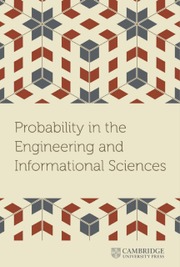Article contents
ON A GENERALIZED Q-URN MODEL
Published online by Cambridge University Press: 15 September 2014
Abstract
Recently, Chen, Hsiau & Yang [1] proposed a new two-urn model with red and white balls and showed that the fractions of red balls in both urns converge almost surely to the same limit. We extend the results for the two-urn model to the q-urn model (q≥3) with similar dynamics of drawing and adding balls. We use matrix forms and martingale theory to show that the fractions of red balls in all urns converge almost surely to the same limit.
- Type
- Research Article
- Information
- Probability in the Engineering and Informational Sciences , Volume 29 , Issue 1 , January 2015 , pp. 99 - 115
- Copyright
- Copyright © Cambridge University Press 2014
References
- 1
- Cited by


